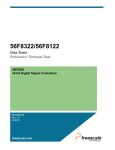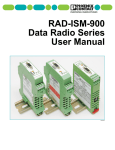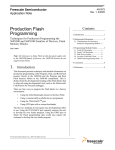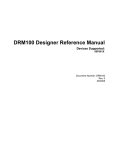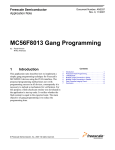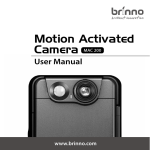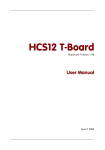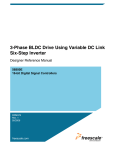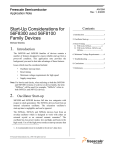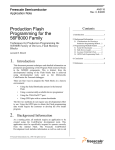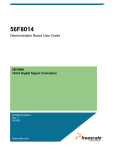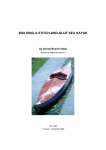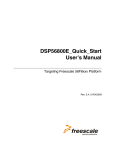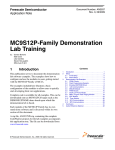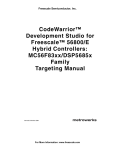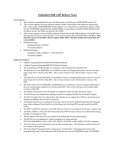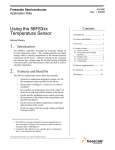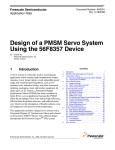Download 56F801XBLUG, 56F801x Serial Bootloader - User`s Guide
Transcript
56F801x
Serial Bootloader User Guide
56F8000
16-bit Digital Signal Controllers
56F801xBLUG
Rev. 1.0
12/2005
freescale.com
TABLE OF CONTENTS
About This Document
Audience . . . . . . . . . . . . . . . . . . . . . . . . . . . . . . . . . . . . . . . . . . . . . . . . . . . . . . . . . . . . . . . . . v
Organization . . . . . . . . . . . . . . . . . . . . . . . . . . . . . . . . . . . . . . . . . . . . . . . . . . . . . . . . . . . . . . v
•Suggested Reading . . . . . . . . . . . . . . . . . . . . . . . . . . . . . . . . . . . . . . . . . . . . . . . . . . . . . . . . v
•Conventions. . . . . . . . . . . . . . . . . . . . . . . . . . . . . . . . . . . . . . . . . . . . . . . . . . . . . . . . . . . . . . vi
•Definitions, Acronyms, and Abbreviations . . . . . . . . . . . . . . . . . . . . . . . . . . . . . . . . . . . . . . .vii
•References . . . . . . . . . . . . . . . . . . . . . . . . . . . . . . . . . . . . . . . . . . . . . . . . . . . . . . . . . . . . . .vii
Chapter 1
Bootloader
1.1
Serial Bootloader . . . . . . . . . . . . . . . . . . . . . . . . . . . . . . . . . . . . . . . . . . . . . . . . . . . . 1-1
1.1.1
Start-up Sequence with Bootloader . . . . . . . . . . . . . . . . . . . . . . . . . . . . . . . . . . . 1-2
1.1.2
Bootloader History . . . . . . . . . . . . . . . . . . . . . . . . . . . . . . . . . . . . . . . . . . . . . . . . 1-3
1.1.3
Files . . . . . . . . . . . . . . . . . . . . . . . . . . . . . . . . . . . . . . . . . . . . . . . . . . . . . . . . . . . 1-3
1.1.4
Bootloader Hardware Set-up . . . . . . . . . . . . . . . . . . . . . . . . . . . . . . . . . . . . . . . . 1-6
1.1.5
Host Terminal Set-up . . . . . . . . . . . . . . . . . . . . . . . . . . . . . . . . . . . . . . . . . . . . . . 1-6
1.1.6
Build . . . . . . . . . . . . . . . . . . . . . . . . . . . . . . . . . . . . . . . . . . . . . . . . . . . . . . . . . . . 1-7
1.1.7
Download into Program Flash. . . . . . . . . . . . . . . . . . . . . . . . . . . . . . . . . . . . . . . . 1-7
1.1.8
Execute . . . . . . . . . . . . . . . . . . . . . . . . . . . . . . . . . . . . . . . . . . . . . . . . . . . . . . . . . 1-8
1.1.9
Requirements for a Loaded Program . . . . . . . . . . . . . . . . . . . . . . . . . . . . . . . . . . 1-8
1.1.10
S-Record Generation . . . . . . . . . . . . . . . . . . . . . . . . . . . . . . . . . . . . . . . . . . . . . . 1-8
1.1.11
Peripheral Usage . . . . . . . . . . . . . . . . . . . . . . . . . . . . . . . . . . . . . . . . . . . . . . . . . 1-9
1.1.12
Performance Data. . . . . . . . . . . . . . . . . . . . . . . . . . . . . . . . . . . . . . . . . . . . . . . . 1-10
1.1.13
Troubleshooting . . . . . . . . . . . . . . . . . . . . . . . . . . . . . . . . . . . . . . . . . . . . . . . . . 1-10
Chapter 2
License
2.1
Limited Use License Agreement . . . . . . . . . . . . . . . . . . . . . . . . . . . . . . . . . . . . . . . . 2-1
Appendix A
Serial Bootloader Test Application
Appendix B
Serial Bootloader Revision History
Table of Contents, Rev. 1.0
Freescale Semiconductor
Preliminary
i
56F801x Bootloader User Guide, Rev. 1.0
ii
Freescale Semiconductor
Preliminary
LIST OF FIGURES
Figure 1-1
Figure 1-2
Figure 1-3
Figure 1-4
Figure 1-5
Figure 1-6
Figure B-1
Programming Flash on a 56F801x Device . . . . . . . . . . . . . . . . . . . . . . . . . . . . . 1-1
Serial Bootloader Directory Structure and Files. . . . . . . . . . . . . . . . . . . . . . . . . . 1-4
Loading a User’s Application via Serial Bootloader . . . . . . . . . . . . . . . . . . . . . . . 1-6
HyperTerminal Configuration Example . . . . . . . . . . . . . . . . . . . . . . . . . . . . . . . . 1-7
S-Record Settings in the User Application’s Project Settings . . . . . . . . . . . . . . . 1-9
Serial Bootloader Status Code . . . . . . . . . . . . . . . . . . . . . . . . . . . . . . . . . . . . . 1-11
HyperTerminal Configuration Example for Versions 1.2 and Lower . . . . . . . . . . B-2
List of Figures, Rev. 1.0
Freescale Semiconductor
Preliminary
iii
568F801x Bootloader User Guide, Rev. 1.0
iv
Freescale Semiconductor
Preliminary
About This Document
This manual describes the 56F801x Serial Bootloader application.
Audience
This manual targets software developers utilizing the 56F801x Bootloader applications.
Organization
This manual consists of the following sections:
•
Chapter 1, Bootloader -- describes the Serial Bootloader.
•
Chapter 2, License -- provides the license required to use this product.
Suggested Reading
We recommend that you have a copy of the following references:
•
Freescale DSP56800E Reference Manual, DSP56800ERM
•
56F8000 Peripheral Reference Manual, MC56F8000RM
•
Inside CodeWarrior: Core Tools, Freescale Inc.
Preface, Rev. 1.0
Freescale Semiconductor
Preliminary
v
Conventions
This document uses the following notational conventions:
Typeface, Symbol or
Meaning
Term
Courier
Code examples
Monospaced Type
Italic
Directory names,
project names,
calls,
functions,
statements,
procedures,
routines,
arguments,
file names,
applications,
variables,
directives,
code snippets
in text
Bold
Reference sources,
paths,
emphasis
Blue Text
Number
ALL CAPITAL
LETTERS
Brackets [...]
Quotation
marks, “...”
Examples
//Process command for line flash
...and contains these core directories:
applications contains applications software...
...CodeWarrior project, 3des.mcp is...
...the pConfig argument....
...defined in the C header file, aec.h....
...refer to the Targeting 56F801x Platform
manual....
...see: C:\Program Files\Motorola\Embedded
SDK\help\tutorials
Linkable on-line
...refer to Chapter 7, License....
Any number is considered a 3V
positive value, unless
-10
preceded by a minus
DES-1
symbol to signify a negative
value
# defines/
# define INCLUDE_STACK_CHECK
defined constants
Function keys
...by pressing function key [F7]
Returned messages
...the message, “Test Passed” is displayed....
...if unsuccessful for any reason, it will return “NULL”...
56F801x Bootloader User Guide, Rev. 1.0
vi
Freescale Semiconductor
Preliminary
Definitions, Acronyms, and Abbreviations
The following list defines the acronyms and abbreviations used in this document. As this
template develops, this list will be generated from the document. As we develop more group
resources, these acronyms will be easily defined from a common acronym dictionary. Please note
that while the acronyms are in solid caps, terms in the definition should be initial capped ONLY
IF they are trademarked names or proper nouns.
COP
Computer Operating Properly
DSC
Digital Signal Controller
EVM
Evaluation module
FM
Flash Module
IDE
Integrated Development Environment
PC
Personal Computer
PLL
Phase Locked Loop
RAM
Random Access (read/write) Memory
SCI
Serial Communications Interface
References
The following sources were used to produce this book:
1. Freescale DSP56800E Reference Manual, DSP56800ERM
2. 56F8000 Peripheral Reference Manual, MC56F8000RM
3. Freescale website:
www.freescale.com
Preface, Rev. 1.0
Freescale Semiconductor
Preliminary
vii
56F801x Bootloader User Guide, Rev. 1.0
viii
Freescale Semiconductor
Preliminary
Serial Bootloader
Chapter 1
Bootloader
1.1 Serial Bootloader
All 56F801x family devices are preprogrammed with the Serial Bootloader application. The
Serial Bootloader has been developed to load and run a proprietary user application presented as
an S-Record file into the Program Memory. The Serial Bootloader is located in the dedicated
Program Memory region, called Program Flash. The Serial Bootloader supports the simplest
serial protocol, so any standard serial terminal program can be used on the host PC.
The Serial Bootloader application reads the S-Record file of a user application (for example,
generated by CodeWarrior) via serial interface, parses this S-Record file, and stores needed data
in Program Flash memory. When the processing of the S-Record file is finished, the Bootloader
will remain in an infinite loop. Resetting the device will allow the downloaded application to be
launched. If any error occurs while loading the S-Record file, the Bootloader outputs an error
message via the serial line and will prompt the user to resend the S-Record file. See Figure 1-1.
Program Flash
S-Record
Bootloader
Running
SCI
S-Record
Figure 1-1. Programming Flash on a 56F801x Device
Bootloader, Rev. 1.0
Freescale Semiconductor
Preliminary
1-1
Serial Bootloader
1.1.1 Start-up Sequence with Bootloader
The following steps describe the Bootloader’s start-up sequence.
1.1.1.1 Step 1: Power-up/Reset
The 56800E core specifies two reset vectors: Hardware Reset and COP Reset. The reset vectors
are each two words wide, and reside in consecutive addresses in the beginning of Program Flash.
The Hardware Reset vector identifies the address the processor accesses after a power-on reset,
external reset, or software reset. The COP Reset vector is accessed after a watchdog time-out.
When the 56F801x Bootloader is present, both reset vectors will contain an entry point to the
Serial Bootloader application. Once the Serial Bootloader has begun reprogramming the Flash,
the entire Flash will be erased. Since this affects the reset vectors, it is critical that no resets are
asserted until the Serial Bootloader application has concluded.
1.1.1.2 Step 2: Transfer Code from Program Flash to RAM
Before the Serial Bootloader application can execute, portions of the software must be moved
from Program Flash to RAM. This is necessary because the Program Flash is to be erased and
reprogrammed with new data. Only the portions of the Serial Bootloader application used to
reprogram Flash with S-record data are transferred. Initialization code used by the Serial
Bootloader application will be lost once the application has begun modifying Program Flash.
1.1.1.3 Step 3: Write New Application to Program Flash
Once the Serial Bootloader has processed a valid S0 S-record, it erases the entire Program Flash
in anticipation of new data. Program Flash is written with new data each time a valid S3 S-record
has been processed. The Serial Bootloader application will not reprogram any RAM locations. In
the event of an error, a notification will be sent over the serial port. The application will flush all
data associated with the current S-record file and wait for the user to send a new S-record file.
1.1.1.4 Step 4: Switch to New Application
Once the 56F801x Serial Bootloader has reprogrammed the Flash with the data from the S-record
file, it enters an infinite loop to prevent further code execution. A hardware reset is necessary to
begin executing the downloaded application. The reset causes the processor to begin executing
code contained in the Hardware Reset vector (which should now contain a JMP instruction to an
address used as the entry point for the new application). The reset also returns all peripheral
registers to default values.
56F801x Bootloader User Guide, Rev. 1.0
1-2
Freescale Semiconductor
Preliminary
Serial Bootloader
1.1.2 Bootloader History
The most current version of the Bootloader is 1.5. When running the Serial Bootloader
application, the version number is contained in a message transmitted over the serial port. The
Bootloader version history can be seen in the following table; see Appendix B for functionality
differences between versions.
Known Issues:
a. A default terminal serial program line-ending character terminator is not supported.
Work around through the serial application configuration. See Appendix B for the
work-around.
b. XON/XOFF flow control requires 2ms line delays. Work around through the serial
application configuration. See Appendix B for the work-around.
c. An odd number of data bytes in S3 Record will hang execution. A work-around PERL
script is available on the Freescale FAQ website:
http://faqts.freescale.net
FAQ# 25759 contains the script, as well as a detailed explanation of the problem.
Table 1-1. Software Revision History
Version Number
Known Issues
1.2
1.3
1.5
a,b,c
c
Actions/Resolutions
Corrected “a” and “b”
Corrected “c”
1.1.3 Files
The Serial Bootloader application was developed using CodeWarriorTM with Processor
ExpertTM (PE) and makes use of the standard files generated for PE projects. Some of the
standard PE files were modified, however, to support special functionality needed by the
application.
Bootloader, Rev. 1.0
Freescale Semiconductor
Preliminary
1-3
Serial Bootloader
Figure 1-2. Serial Bootloader Directory Structure and Files
Support
This directory contains run time libraries imported when using the Codewarrior tool. The
contents of this directory can not be modified.
56F801x Bootloader User Guide, Rev. 1.0
1-4
Freescale Semiconductor
Preliminary
Serial Bootloader
Generated Code
This directory contains source code generated by the Processor Expert (PE) stationery and beans.
Files within this directory may be modified if changes are made to project or bean settings. It
should be noted, however, that the linker command file, smm_pROM_pRAM.cmd, has been
customized for the Serial Bootloader application and, to ensure correct operation of the
Bootloader software, should not be modified. When compiling the Bootloader software, do not
enable the CPU bean property to build the linker command file, as this will result in overwriting
the customized file.
Start-up Code
This directory contains the start-up assembly code, 56F80xx_init.asm, responsible for initializing
the core registers and internal memory. This includes the Operating Mode Register (OMR), Stack
Pointer (SP), and Hardware Stack (HWS), as well as the on-chip RAM.
User Modules
All files within this directory are customized files, not generated by Processor Expert. The
bootloader.c file contains the main() function, which controls the Serial Bootloader application
flow. The bootloader_lib.c file contains various utilities for acheving the functionality required
by the Serial Bootloader application.
Doc
This directory contains miscellaneous files generated by the Processor Expert tool, related to
project settings and the stationery used.
Set-up
This directory contains set-up files used to configure serial communication applications, such as
HyperTerminal and Tera Term Pro.
Test
This directory contains various S-record files used to test the Serial Bootloader application.
The Serial Bootloader application source code is available on the Freescale website
(http://www.freescale.com) and contains the Serial Bootloader application source code and
other associated files. To download the Serial Bootloader package, go to:
Products / Digital Signal Processors and Controllers / 56800/E / 56F8013 / Design Tools /
Software / Application Software / 56F801x Bootloader
Bootloader, Rev. 1.0
Freescale Semiconductor
Preliminary
1-5
Serial Bootloader
1.1.4 Bootloader Hardware Set-up
These requirements must be met to use the Bootloader:
•
•
It must be programmed into Program Flash
The RS-232 socket must be connected by serial cable with the host PC’s COM serial port
(See Figure 1-3)
56F801x Board
S-Record
RS-232
Figure 1-3. Loading a User’s Application via Serial Bootloader
1.1.5 Host Terminal Set-up
A host terminal program is used to communicate with the Bootloader. The terminal must be
configured to the following mode:
Table 1-2. PC Serial Communication Settings
Baud Rate
Note:
115200bps
Data Format
8N1 (8 data bits, no parity, 1 stop bit character format)
Flow Control Protocol
Xon / Xoff
See Appendix B for additional configuration options required by Serial Bootloader
versions prior to 1.3.
Once your serial port has been properly configured, the serial communications application should
be capable of displaying any 56F801x Serial Bootloader messages. An example of how to obtain
this configuration using HyperTerminal follows.
56F801x Bootloader User Guide, Rev. 1.0
1-6
Freescale Semiconductor
Preliminary
Serial Bootloader
Figure 1-4. HyperTerminal Configuration Example
1.1.6 Build
All 56F801x devices should be preprogrammed with the Serial Bootloader application. However,
source code is provided in the event it is necessary to reprogram a 56F801x device with the Serial
Bootloader application via CodeWarrior (see Section 1.1.3).
To build the Serial Bootloader, first open the bootloader.mcp project file using the CodeWarrior
IDE. Although this project uses the 56F8013 CPU bean, it is not necessary to change the target
processor when building for other 56F801x devices. This single project generates code
executable on all 56F801x devices. Next, select the Project/Make command, which builds and
links the Serial Bootloader application.
1.1.7 Download into Program Flash
Load the software onto the 56F801x device by choosing the Project/Debug command in the
CodeWarrior IDE. Make sure all hardware has been properly configured before attempting to
download the software.
Bootloader, Rev. 1.0
Freescale Semiconductor
Preliminary
1-7
Serial Bootloader
1.1.8 Execute
Once the 56F801x Serial Bootloader has been downloaded, the Bootloader will run automatically
after a reset has been asserted on the device. If the terminal program is properly set up and the
EVM and the Host PC are properly connected, the terminal program will display the following
version number and wait for S-record download:
"MC56F801x Serial Bootloader v1.5"
"Waiting for S-record file ..."
To load the S-Record file using HyperTerminal, use the “Transfer/Send Text File” menu option
to select the desired S-Record file. If the download attempt is successful, the following message
will be displayed:
"Download complete"
When an error is detected while downloading the S-Record file, the 56F801x Serial Bootloader
displays an error message and waits for the transmission of another S-record file. The following
example of this scenario appears:
"Error: 3001"
"Waiting for S-record file ..."
Note:
Consult Troubleshooting, Section 1.1.13, for information on decoding error messages.
1.1.9 Requirements for a Loaded Program
If the application is to be loaded via the Bootloader, it must meet the following requirements:
•
•
•
Application Entry Point - The hardware reset vector must be present at the beginning of
Program Flash
Initialized Data - All variables must be initialized via program code. Although it is
possible to generate S-records that contain data used to initialize RAM, this data will be
ignored by the Serial Bootloader application.
Restricted Resources - The S-record used for download should not contain any data
targeted for RAM. The Serial Bootloader uses this region of memory to execute code used
to erase and program Flash, as well as to download and parse S-record data. If data is
needed in RAM, it should be loaded into Program Flash and copied into RAM at run time
(this is handled automatically when using the Processor Expert stationery).
1.1.10 S-Record Generation
Figure 1-5 illustrates how a user’s application can be set up within Code Warrior to generate an
S-Record needed by the Bootloader to program the user’s application into the 56F801x device’s
Flash. The options for S-Record generation are circled in blue.
56F801x Bootloader User Guide, Rev. 1.0
1-8
Freescale Semiconductor
Preliminary
Serial Bootloader
Figure 1-5. S-Record Settings in the User Application’s Project Settings
The “Max Record Length” option gives the maximum number of bytes that can be used to
comprise the address and data fields for a given S-Record. To reduce S-Record parsing overhead,
this option should be set with a large number. Although the maximum value for this option is
“255”, CodeWarrior will use “252” by default.
The “EOL Character” option determines what type of line ending will be used for the S-Record
file. To ensure proper parsing of the S-Record file, this option must be set to “DOS”.
1.1.11 Peripheral Usage
The 56F801x Serial Bootloader uses the Flash Module (FM), Interrupt Controller (ITCN),
On-Chip Clock Synthesis (OCCS), Phase-Locked Loop (PLL), and Serial Communications
Interface (SCI) peripherals. The PLL clock is enabled to allow a 32MHz system clock, and
assumes the Internal Relaxation Oscillator input frequency is 8MHz. The FM Clock Divide value
used by the application also assumes an 8MHz Internal Relaxation Oscillator input. The SCI
Baud Rate value used was calculated to achieve 115,200 baud communication, assuming a
Bootloader, Rev. 1.0
Freescale Semiconductor
Preliminary
1-9
Serial Bootloader
32MHz system clock. After downloading a new application with the Serial Bootloader, a
hardware reset is required to run the application. The hardware reset will restore all peripheral
registers to default values before running the new application.
1.1.12 Performance Data
The Serial Bootloader application consumes 838 words (approximately 1.64 kB) of Program
Flash. The Serial Bootloader is capable of programming the entire flash array in under 5 seconds
in most cases. Of course, the actual performance will depend on the PC, Operating System, and
serial application used. Below are some sample download times for programming the 56F8013
device using HyperTerminal and Tera Term Pro.
Table 1-3. Sample Download Times for 16KB Memory
Serial Application
PC Type
Windows 2000
Windows XP
HyperTerminal
Pentium-4 1.7 GHz
4.46 seconds
4.75 seconds
Tera Term Pro
Pentium-3 1.0 GHz
3.75 seconds
4.29 seconds
1.1.13 Troubleshooting
The Serial Bootloader application checks for the following error conditions:
•
•
•
•
•
SCI Receiver Error
Flash Programming Error (Access Error, Protection Violation)
Flash Verify Error
Invalid S-Record Checksum
Invalid S-Record Type
If any of these errors are encountered, the Serial Bootloader application will generate an error
message and prompt the user to download the S-Record file again. The following text illustrates
what is seen on the PC host terminal in the event of a download error:
"MC56F801x Serial Bootloader v1.5"
"Waiting for S-record file ..."
"PROGRAM&DATA***"
"Error: 3002"
"Waiting for S-record file ..."
In the progress message, PROGRAM&DATA***, each asterisk indicates a succesfully processed
S-record. This information can can be used with the status code, Error: 3002, to determine
whether or not an S-record file contains bad data. The status code is a 16-bit hexadecimal
56F801x Bootloader User Guide, Rev. 1.0
1-10
Freescale Semiconductor
Preliminary
Serial Bootloader
number, containing a variety of status and error flags controlled by the Serial Bootloader
application; see Figure 1-6.
15
14
13
12
RX
EOF
RX
HEADER
TX
XOFF
11 10 9 8 7
6
ERR
SCI_RX
5
4
3
2
1
0
ERR
ERR
ERR
ERR
ERR
FM_PROG FM_PVIOL FM_ACCERR TYPE CKSUM
Figure 1-6. Serial Bootloader Status Code
A description of each bit used in the Serial Bootloader status code is provided in Table 1-4.
Please consult this table for possible errors and resolutions when troubleshooting the Serial
Bootloader application.
Bootloader, Rev. 1.0
Freescale Semiconductor
Preliminary
1-11
Serial Bootloader
Table 1-4. Bootloader Troubleshooting Guide
Status Code
ERR_CKSUM
ERR_TYPE
Description
Possible Cause(s)
Solution(s)
The checksum calculated
by the Bootloader does not
match the S-record
checksum field
S-record file corrupted
Regenerate the S-record
by rebuilding the
application
Noisy serial cable
Ensure the serial cable is
properly connected and/or
replace it with a new cable
An invalid S-record type
was received.
S-record file corrupted
Regenerate the S-record
by rebuilding the
application
Noisy serial cable
Ensure the serial cable is
properly connected and/or
replace it with a new cable
Only S0, S3 and S7
records are supported by
the Serial Bootloader
application.
ERR FM_ACCERR
An access error was
encountered when
programming the Flash
On-chip Flash Module
failure
Contact Freescale
Technical Support
ERR FM_PVIOL
A protection violation was
encountered when
programming the Flash
On-chip Flash Module
failure
Contact Freescale
Technical Support
ERR FM_PROG
The Flash program / read
verify failed for a word in
the Flash array
On-chip Flash Module
failure
Contact Freescale
Technical Support
ERR SCI_RX
An SCI receive error was
detected when
downloading the S-record
(e.g., noise, frame, and /or
receiver overrun
Noisy serial cable
Ensure the serial cable is
properly connected and/or
replace it with a new cable
Incorrect PC host terminal
serial program baud rate
selected
See Section 1.1.5 for
correct configuration
PC host terminal serial
program transmitted
break character
Do not send break
characters
TX XOFF
APPLICATION STATUS
FLAG
The ASCII “XOFF”
character (0x13) was sent
to the PC terminal to halt
transmission
N/A
RX HEADER
APPLICATION STATUS
FLAG
The SO record was
received and processed
N/A
RX EOF
APPLICATION STATUS
FLAG
The S7 record was
received and processed
N/A
Unshaded rows = Error Indicators
Shaded rows = Status Indicators
56F801x Bootloader User Guide, Rev. 1.0
1-12
Freescale Semiconductor
Preliminary
Limited Use License Agreement
Chapter 2
License
2.1 Limited Use License Agreement
LIMITED USE LICENSE AGREEMENT
PLEASE READ THIS AGREEMENT CAREFULLY BEFORE USING THIS SOFTWARE.
BY USING OR COPYING THE SOFTWARE, YOU AGREE TO THE TERMS OF THIS
AGREEMENT.
The software in either source code form ("Source") or object code form ("Object") (cumulatively
hereinafter "Software") is provided under a license agreement ("Agreement") as described herein.
Any use of the Software including copying, modifying, or installing the Software so that it is
usable by or accessible by a central processing unit constitutes acceptance of the terms of the
Agreement by the person or persons making such use or, if employed, the employer thereof
("Licensee") and if employed, the person(s) making such use hereby warrants that they have the
authority of their employer to enter this license agreement. If Licensee does not agree with and
accept the terms of this Agreement, Licensee must return or destroy any media containing the
Software or materials related thereto, and destroy all copies of the Software.
The Software is licensed to Licensee by Freescale Semiconductor Inc. ("Freescale") for use under
the terms of this Agreement. Freescale retains ownership of the Software. Freescale grants only
the rights specifically granted in this Agreement and grants no other rights. Title to the Software,
all copies thereof and all rights therein, including all rights in any intellectual property including
patents, copyrights, and trade secrets applicable thereto, shall remain vested in Freescale.
For the Source, Freescale grants Licensee a personal, non-exclusive, non-assignable, revocable,
royalty-free right to use, copy, and make derivatives of the Source solely in a development
system environment in order to produce object code solely for operating on a Freescale
semiconductor device having a central processing unit ("Derivative Object").
For the Object and Derivative Object, Freescale grants Licensee a personal, non-exclusive,
non-assignable, revocable, royalty-free right to copy, use, and distribute the Object and the
Derivative Object solely for operating on a Freescale semiconductor device having a central
processing unit.
Licensee agrees to: (a) not use, modify, or copy the Software except as expressly provided herein,
(b) not distribute, disclose, transfer, sell, assign, rent, lease, or otherwise make available the
License, Rev. 1.0
Freescale Semiconductor
Preliminary
2-1
Limited Use License Agreement
Software, any derivatives thereof, or this license to a third party except as expressly provided
herein, (c) not remove obliterate, or otherwise defeat any copyright, trademark, patent or
proprietary notices, related to the Software (d) not in any form export, re-export, resell, ship or
divert or cause to be exported, re-exported, resold, shipped, or diverted, directly or indirectly, the
Software or a direct product thereof to any country which the United States government or any
agency thereof at the time of export or re-export requires an export license or other government
approval without first obtaining such license or approval.
THE SOFTWARE IS PROVIDED ON AN "AS IS" BASIS AND WITHOUT WARRANTY OF
ANY KIND INCLUDING (WITHOUT LIMITATION) ANY WARRANTIES OF
MERCHANTABILITY OR FITNESS FOR A PARTICULAR PURPOSE. IN NO EVENT
SHALL FREESCALE BE LIABLE FOR ANY LIABILITY OR DAMAGES OF ANY KIND
INCLUDING, WITHOUT LIMITATION, DIRECT OR INDIRECT OR INCIDENTAL OR
CONSEQUENTIAL OR PUNITIVE DAMAGES OR LOST PROFITS OR LOSS OF USE
ARISING FROM USE OF THE SOFTWARE OR THE PRODUCT REGARDLESS OF THE
FORM OF ACTION OR THEORY OF LIABILITY (INCLUDING WITHOUT LIMITATION,
ACTION IN CONTRACT, NEGLIGENCE, OR PRODUCT LIABILITY) EVEN IF
FREESCALE HAS BEEN ADVISED OF THE POSSIBILITY OF SUCH DAMAGE. THIS
DISCLAIMER OF WARRANTY EXTENDS TO LICENSEE OR USERS OF PRODUCTS
AND IS IN LIEU OF ALL WARRANTIES WHETHER EXPRESS, IMPLIED, OR
STATUTORY, INCLUDING IMPLIED WARRANTIES OF MERCHANTABILITY OR
FITNESS FOR PARTICULAR PURPOSE.
Freescale does not represent or warrant that the Software is free of infringement of any third party
patents, copyrights, trade secrets, or other intellectual property rights or that Freescale has the
right to grant the licenses contained herein. Freescale does not represent or warrant that the
Software is free of defect, or that it meets any particular requirements or need of the Licensee, or
that it conforms to any documentation, or that it meets any standards.
Freescale shall not be responsible to maintain the Software, provide upgrades to the Software, or
provide any field service of the Software. Freescale reserves the right to make changes to the
Software without further notice to Licensee.
The Software is not designed, intended, or authorized for use as components in systems intended
for surgical implant into the body, or other applications intended to support or sustain life, or for
any other application in which the failure of the Software could create a situation where personal
injury or death may occur. Should Licensee purchase or use the Software for any such
unintended or unauthorized application, Licensee shall indemnify and hold Freescale and its
officers, employees, subsidiaries, affiliates, and distributors harmless against all claims, costs,
damages, and expenses, and reasonable attorney fees arising out of, directly or indirectly, any
56F801x Bootloader User Guide, Rev. 1.0
2-2
Freescale Semiconductor
Preliminary
Limited Use License Agreement
claim of personal injury or death associated with such unintended or unauthorized use, even if
such claim alleges that Freescale was negligent regarding the design or manufacture of the
Software.
The term of this Agreement is for as long as Licensee uses the Software for its intended purpose
and is not in default of any provisions of this Agreement. Freescale may terminate this
Agreement if Licensee is in default of any of the terms and conditions of this Agreement.
This Agreement shall be governed by and construed in accordance with the laws of the State of
Arizona and can only be modified in a writing signed by both parties. Licensee agrees to
jurisdiction and venue in the State of Arizona.
By using, modifying, installing, compiling, or copying the Software, Licensee acknowledges that
this Agreement has been read and understood and agrees to be bound by its terms and conditions.
Licensee agrees that this Agreement is the complete and exclusive statement of the agreement
between Licensee and Freescale and supersedes any earlier proposal or prior arrangement,
whether oral or written, and any other communications relative to the subject matter of this
Agreement.
License, Rev. 1.0
Freescale Semiconductor
Preliminary
2-3
Limited Use License Agreement
56F801x Bootloader User Guide, Rev. 1.0
2-4
Freescale Semiconductor
Preliminary
Appendix A
Serial Bootloader Test Application
A simple test application is provided for the Serial Bootloader application. This application fills
the entire Program Flash array with functional code, along with a sequential data pattern. When
executed, the application checks for the expected pattern of data in the Program Flash locations
not used for storing code. If the data pattern verification was successful, the application blinks a
series of LEDs connected to GPIOA[2:0] at 1Hz. Otherwise, the LEDs will remain off to indicate
failure.
Versions of the test application are available in S-record format for each 56F801x device (i.e.,
test_app_56F8013, test_app_56F8014) on the Freescale website (http://www.freescale.com) as
part of the 56F801x Serial Bootloader software package. The test application source code is also
available on the website. To obtain any desired files, go to:
Products / Digital Signal Processors and Controllers / 56800/E / 56F8013 / Design Tools /
Software / Application Software
Serial Bootloader Test Application, Rev. 1.0
Freescale Semiconductor
Preliminary
Appendix A-1
56F801x Bootloader User Guide, Rev. 1.0
Appendix A-2
Freescale Semiconductor
Preliminary
Appendix B
Serial Bootloader Revision History
This document was targeted for the most recent version of the 56F801x Serial Bootloader. You
should reference this section if you are using an older version of the Bootloader software, where
some of the differences in functionality of the older revisions will be covered in detail.
•
Bootloader Messages
While newer versions of the Bootloader (1.3 and higher) show an error code containing the types
of errors encountered, previous versions do not send such a descriptive message. The following
block of text is an example of what is seen on a terminal program when an error occurs on a
device running Bootloader versions 1.2 and lower:
"MC56F801x Serial Bootloader v1.1"
"Waiting for S-record file ..."
"PROGRAM&DATA***"
"Download Aborted!"
"Waiting for S-record file ..."
•
Host Terminal Set-up
Bootloader versions 1.2 and lower require additional terminal configuration options; additional
options are highlighted in bold in Table B-1 .
Table B-1. PC Serial Communication Settings for Versions 1.2 and Lower
Baud Rate
115200bps
Data Format
8NI (8 data bits, no parity, 1 stop bit character format)
Flow Control Protocol
Xon / Xoff
Line Delay
2ms
Line Ending
“\r” (carriage return), followed by “\n” (newline)
Figure B-1 shows how to configure HyperTerminal for use with 56F801x Serial Bootloader
Versions 1.2 and lower.
Serial Bootloader Revision History, Rev. 1.0
Freescale Semiconductor
Preliminary
Appendix B-1
Figure B-1. HyperTerminal Configuration Example for Versions 1.2 and Lower
•
S-Record Formatting
Bootloader versions 1.3 and lower are unable to fully process data in S3 records if the S-record
data field contains an odd number of bytes. These versions of software assumed that all S3
records would contain an even number of actual data bytes. This assumption was based on the
fact the 56800/E is a 16-bit architecture with 16-bit program opcodes.
A PERL script is available to modify S-record files containing odd S3 data. After using the script
to convert an S-record file, it should be safe to use on all versions of the Bootloader software.
Instructions for use are embedded within the script itself, and can be referenced by executing the
script with an “-h” or “-help” option in the command line. Please reference the Freescale FAQ
website, http://faqts.freescale.net, to obtain this script; see FAQ #25759.
It is recommended, however, that users take advantage of the 1.5 release. Version 1.5 of the
Bootloader handles the odd S3 data field issue in the Bootloader application. It accomplishes this
by appending 0xFF to the S3 data if the record contains an odd number of data field bytes. This
fix does not affect the S-record checksum calculation. To obtain version 1.5, go to:
Products / Digital Signal Processors and Controllers / 56800/E / 56F8013 / Design Tools /
Software / Application Software / 56F801x Bootloader
56F801x Bootloader User Guide, Rev. 1.0
Appendix B-2
Freescale Semiconductor
Preliminary
INDEX
Symbols
R
56F8000 Peripheral User Manual Preface-v, Preface-vii
RAM Preface-vii
Random Addess Memory
RAM Preface-vii
C
Computer Operating Properly
COP Preface-vii
COP Preface-vii
D
Digital Signal Controller
DSC Preface-vii
DSC Preface-vii
S
SCI Preface-vii
Serial Communications Interface
SCI Preface-vii
S-Record file 1-1
E
Evaluation Module
EVM Preface-vii
EVM Preface-vii
F
Flash Module
FM Preface-vii
FM Preface-vii
Freescale DSP56800E Reference Manual Preface-v,
Preface-vii
I
IDE Preface-vii
Inside CodeWarrior
Core Tools Preface-v
Integrated Development Environment
IDE Preface-vii
P
PC Preface-vii
Personal Computer
PC Preface-vii
Phase Locked Loop
PLL Preface-vii
PLL Preface-vii
Index, Rev. 1.0
Freescale Semiconductor
Preliminary
i
How to Reach Us:
Home Page:
www.freescale.com
E-mail:
[email protected]
USA/Europe or Locations Not Listed:
Freescale Semiconductor
Technical Information Center, CH370
1300 N. Alma School Road
Chandler, Arizona 85224
+1-800-521-6274 or +1-480-768-2130
[email protected]
Europe, Middle East, and Africa:
Freescale Halbleiter Deutschland GmbH
Technical Information Center
Schatzbogen 7
81829 Muenchen, Germany
+44 1296 380 456 (English)
+46 8 52200080 (English)
+49 89 92103 559 (German)
+33 1 69 35 48 48 (French)
[email protected]
Japan:
Freescale Semiconductor Japan Ltd.
Headquarters
ARCO Tower 15F
1-8-1, Shimo-Meguro, Meguro-ku,
Tokyo 153-0064, Japan
0120 191014 or +81 3 5437 9125
[email protected]
Asia/Pacific:
Freescale Semiconductor Hong Kong Ltd.
Technical Information Center
2 Dai King Street
Tai Po Industrial Estate
Tai Po, N.T., Hong Kong
+800 2666 8080
[email protected]
For Literature Requests Only:
Freescale Semiconductor Literature Distribution Center
P.O. Box 5405
Denver, Colorado 80217
1-800-441-2447 or 303-675-2140
Fax: 303-675-2150
[email protected]
RoHS-compliant and/or Pb-free versions of Freescale products have the
functionality and electrical characteristics of their non-RoHS-compliant
and/or non-Pb-free counterparts. For further information, see
http://www.freescale.com or contact your Freescale sales representative.
For information on Freescale’s Environmental Products program, go to
http://www.freescale.com/epp.
Information in this document is provided solely to enable system and
software implementers to use Freescale Semiconductor products. There are
no express or implied copyright licenses granted hereunder to design or
fabricate any integrated circuits or integrated circuits based on the
information in this document.
Freescale Semiconductor reserves the right to make changes without further
notice to any products herein. Freescale Semiconductor makes no warranty,
representation or guarantee regarding the suitability of its products for any
particular purpose, nor does Freescale Semiconductor assume any liability
arising out of the application or use of any product or circuit, and specifically
disclaims any and all liability, including without limitation consequential or
incidental damages. “Typical” parameters that may be provided in Freescale
Semiconductor data sheets and/or specifications can and do vary in different
applications and actual performance may vary over time. All operating
parameters, including “Typicals”, must be validated for each customer
application by customer’s technical experts. Freescale Semiconductor does
not convey any license under its patent rights nor the rights of others.
Freescale Semiconductor products are not designed, intended, or authorized
for use as components in systems intended for surgical implant into the body,
or other applications intended to support or sustain life, or for any other
application in which the failure of the Freescale Semiconductor product could
create a situation where personal injury or death may occur. Should Buyer
purchase or use Freescale Semiconductor products for any such unintended
or unauthorized application, Buyer shall indemnify and hold Freescale
Semiconductor and its officers, employees, subsidiaries, affiliates, and
distributors harmless against all claims, costs, damages, and expenses, and
reasonable attorney fees arising out of, directly or indirectly, any claim of
personal injury or death associated with such unintended or unauthorized
use, even if such claim alleges that Freescale Semiconductor was negligent
regarding the design or manufacture of the part.
Freescale™ and the Freescale logo are trademarks of Freescale Semiconductor,
Inc. All other product or service names are the property of their respective owners.
This product incorporates SuperFlash® technology licensed from SST.
© Freescale Semiconductor, Inc. 2005. All rights reserved.
56F801xBLUG
Rev. 0
12/2005
































